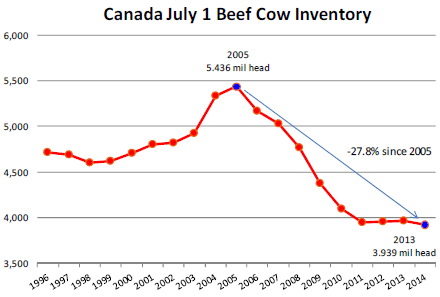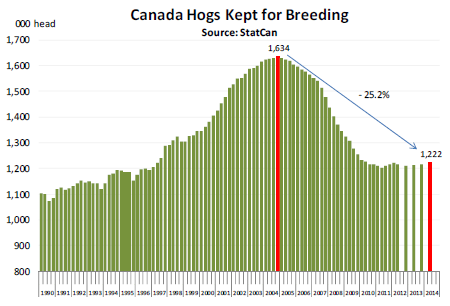Before we look at the highlights from these two important reports, keep in mind that StatCan has discontinued its quarterly hog surveys and now only measures the hog inventory numbers as of 1 January and 1 July.
The Canadian 1 July cattle inventory was pegged t 13.330 million head, down 1.4 per cent from the previous year and now 21 per cent lower from the last inventory peak in 2005. Coming into the report, there had been some hope that higher cattle prices in North America, lower grain prices and improving pasture conditions would help bolster inventory numbers but, so far, that has not been the case.
Indeed, Canadian producers had shown some willingness in rebuilding the herd, holding back more heifers in 2011, 2012 and 2013. With more heifers coming into the herd the decline in beef cow numbers appeared to have bottomed out. Beef cow inventories increased slightly in 2012 and then again in 2013.

This year, however, despite excellent feeder prices and a strong profit outlook, cow-calf producers took a step back and the beef cow inventory declined. With record cow and grinding beef prices, it is likely some producers saw this as an opportunity to sell high.
After all, it is difficult to pass on all time record high cow prices simply because of the hope of good profits down the road. This is the challenge that the beef industry faces today in North America. Consumers are clamoring for beef, leading to all time record high prices and, somewhat perversely, pushing some producers to sell some of the cows and calves they have.
This is especially the case for those part time producers who look at the cows as a asset that has appreciated significantly - when that happens you sell and diversify. The number of heifers held back for herd rebuilding was pegged at 616,200 head, down about 22,300 head (-3.5 per cent) comparted to year ago levels.
Some of those heifers likely have moved south to the US, with the strong US dollar adding to their value. According to USDA data, imports of Canadian breeding female cattle through second week of August were about 16,160 head, up by some 10,235 head (+172 per cent) compared to a year ago. Feeder cattle imports from Canada also have increased by almost 66,000 head so far this year, a 39 per cent increase compared to year ago levels.
The low Canadian cattle inventories and particularly the decline in the breeding herd points to limited beef supplies in the North America for the foreseeable future. The survey did not provide an estimate for the calf crop in Canada for 2014 but we expect the calf crop to continue to decline, reflecting the lower breeding stock numbers.
The Canadian calf crop was 4.888 million head in 2009. By 2013 it had declined to 4.516 million head, a 7 per cent decline in five years and we could see the crop down another 1 to 1.5 per cent in 2014. The lower calf crop and strong demand for feeders and breeding animals in the US will continue to make it challenging to rebuild cattle numbers in Canada for the next few years.
Mid-year hog inventories in Canada were pegged at 12.935 million head, 1.3 per cent higher than the previous year. Similar to the US, Canadian producers have struggled with the effects of PEDv although the impact of the disease has not been as devastating as it has beef for US producers.
The pig crop was pegged at 13.439 million head, down 3 per cent compared to year ago levels. USDA, on the other hand, pegged the 1 June pig crop down 5 per cent compared to a year ago. Different from the US, Canadian producers are slowly adding to the breeding herd.

As of 1 July 2014, the number of hogs kept for breeding pas reported at 1.222 million head, about 0.7 per cent higher than the previous year. A larger breeding herd and a modest recovery in the number of pigs per litter (depending on how PEDv develops later this year) should help bolster hog supplies in 2015. In the short term, however, the lower pig crop numbers imply that overall hog supply growth will continue to be constrained in the short term.





